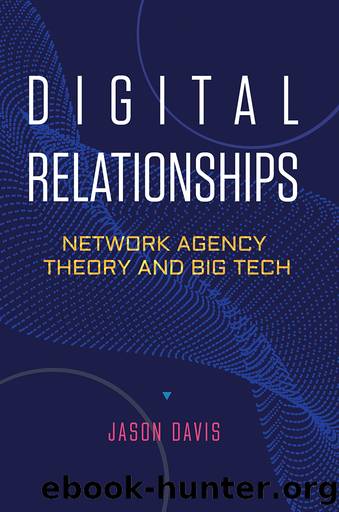Digital Relationships by Jason Davis

Author:Jason Davis
Language: eng
Format: epub
Publisher: Stanford University Press
Published: 2022-08-15T00:00:00+00:00
While marketed primarily as collaboration and human resource management tools, people analytics systems give managers considerable visibility into employeesâ work activities which can be used for monitoring network interactions and their effects, including project assignment, internal communications, and performance outcomes. The adoption of these tools was just emerging across the companies that I studied, so a systematic exploration was not possible. Still, some initial insights emerged.
I found that surveillance-oriented enterprise software tools gave managers insights into employee networks that were useful for interventions. For instance, by observing email and messaging interactions, managers could estimate the total number of ties in the network and thus determine if a problem with excessive network density existed or was growing. At an individual level, managers could monitor individual relationships, discovering who was working with whom and how much investment was being put into each relationship by observing the number of emails or meetings on a calendar. With such information, managers could see not only who had too many ties but also which ties were weak. Interventions directed at strengthening individual relationships leveraged this information.
Information provided by people analytics systems can be used to identify maladaptive brokers and determine the level of intervention necessary, ranging from work directives to broker pruning. This information may also be useful for breaking up status orderings based on the distribution of ties. By graphing networks, managers can identify individuals who are hubs and those who lack sufficient ties to accomplish work objectives. In this way, digital surveillance technologies may promote efficient interventions, as they allow managersâ attention and energies to be better targeted.
Although these digital tools may seem promising for network governance, it is not at all clear that people analytics have a net positive effect on network agency problems. I observed frequent and intense resistance by employees and managers to the adoption of surveillance technologies. Individuals are often deeply uncomfortable with surveillance precisely because of the power it affords managers to intervene in relationships. In some cases, employeesâ sense of violation makes the use of surveillance technologies untenable. Some managers even abandon them. The jury is out on whether this technology is effective in assisting managers in networking interventions.
It is possible that my initial findings are a sign that surveillance technologies will ultimately be viewed as immoral or distasteful in most organizations. Individual managers and employees have always negotiated about the role of new technologies in the wider context of work norms that are developing in society. Yet another possibility is that these technologies will see wide diffusion and come to be accepted by managers and employees alike. Without predicting the exact future, it is reasonable to assume that technology will play a role in future network interventions.
ORGANIZATIONAL FACTORS UNDERLYING THE PERSISTENCE OF NETWORK AGENCY PROBLEMS
This chapter mostly focuses on the internal structural dynamics of networks that determine whether network agency problems persist. In my fieldwork, I noted deep persistence of network agency problems precisely because the networking behaviors that led to them served individual employeeâs interests. This
Download
This site does not store any files on its server. We only index and link to content provided by other sites. Please contact the content providers to delete copyright contents if any and email us, we'll remove relevant links or contents immediately.
Hit Refresh by Satya Nadella(9083)
The Compound Effect by Darren Hardy(8870)
Change Your Questions, Change Your Life by Marilee Adams(7684)
Nudge - Improving Decisions about Health, Wealth, and Happiness by Thaler Sunstein(7656)
The Black Swan by Nassim Nicholas Taleb(7055)
Deep Work by Cal Newport(6966)
Rich Dad Poor Dad by Robert T. Kiyosaki(6513)
Daring Greatly by Brene Brown(6473)
Principles: Life and Work by Ray Dalio(6296)
Playing to Win_ How Strategy Really Works by A.G. Lafley & Roger L. Martin(6082)
Man-made Catastrophes and Risk Information Concealment by Dmitry Chernov & Didier Sornette(5956)
Digital Minimalism by Cal Newport;(5704)
Big Magic: Creative Living Beyond Fear by Elizabeth Gilbert(5676)
The Myth of the Strong Leader by Archie Brown(5456)
The Slight Edge by Jeff Olson(5376)
Discipline Equals Freedom by Jocko Willink(5336)
The Motivation Myth by Jeff Haden(5174)
The Laws of Human Nature by Robert Greene(5080)
Stone's Rules by Roger Stone(5051)
